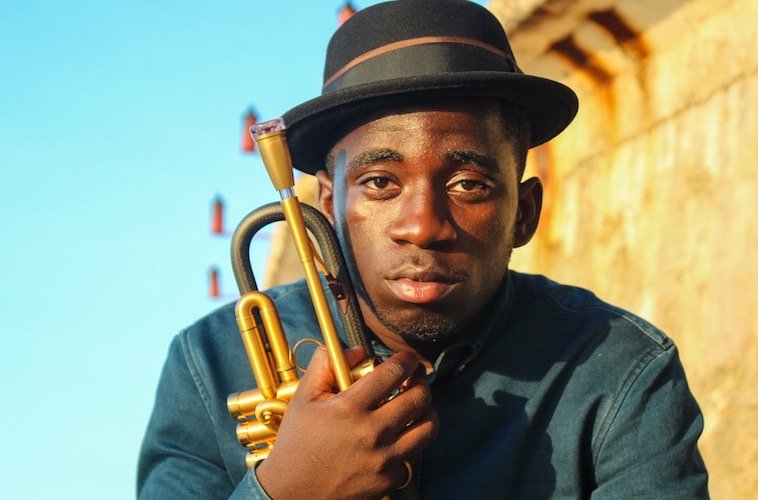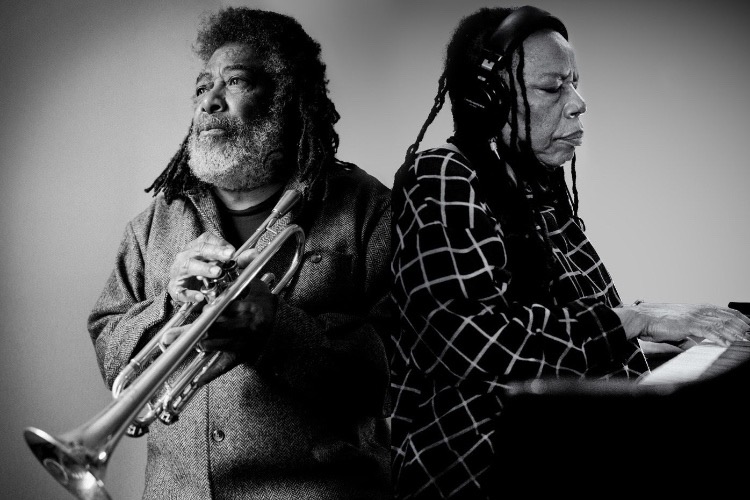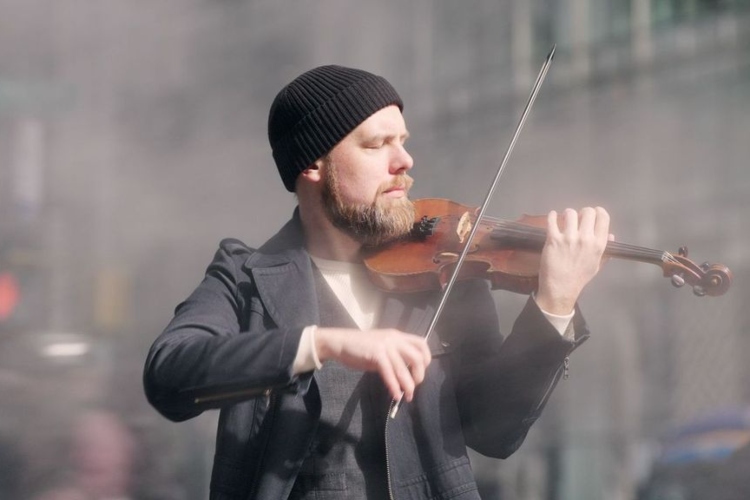Armstrong Now: Giveton Gelin Previews Louis at Newport
|
Getting your Trinity Audio player ready...
|
When one considers a historical museum, thoughts of those no longer with us often come to mind. Figures who made their mark but then left this world. Technically, the Louis Armstrong House Museum in Corona, Queens, commemorates the life of an artist who passed away over fifty-two years ago. But, in a much more real sense, the essence of Satchmo remains with us. Often seen as the first great soloist, his energetic ebullience has permeated into all forms of modern music, “jazz” or otherwise. And even as technology and stylistic choices continue to change the shape of music, Pops remains an essential part of the underlying framework. One of the special sets at this summer’s Newport Jazz Festival, Armstrong Now: Louis at Newport, explores these concepts by pairing three young descendants of the trumpeter’s legacy – Giveton Gelin, Marquis Hill, and Bruce Harris – and allowing them to create new music with Armstrong’s contributions in mind.
Still in his early 20s, Giveton Gelin is a stellar example of how Armstrong’s artistic footprint transcends generations. Gelin is seemingly comfortable with the most recent technologies. He founded InTheShed.Live, an excellent free resource and global network built by and for artists, which Wynton Marsalis has called “the future… of jazz education.” In fact, Gelin even first discovered Armstrong through Youtube videos. His debut recording, True Design (self-release, 2020), builds upon tradition but is thoroughly contemporary. Yet, one finds an energetic warmth and clarity in his tone that reflects lessons learned from the Hot Fives, Hot Sevens, and other works by one of the greatest to ever live, albeit long before the internet age.
We sat down with Gelin to discuss the forthcoming Newport Jazz Festival performance and Armstrong’s influence on his music.
PostGenre: How did the Louis at Newport project come together?
Giveton Gelin: Jake Goldbas [Program Director at the Louis Armstrong House Museum & Archives] was in charge of creating a team of musicians to honor Louis Armstrong’s legacy. Jake got in touch with Marquis Hill and myself, and we decided to look for a third trumpeter. We called Bruce Harris.
PG: Have you worked with Marquis or Bruce before?
GG: Oh, absolutely. I’ve worked with both in many big band settings. But this project is different. We’re working on some cool stuff trumpet-wise with this project and are really stoked
PG: What happened after the three of you were on board for the project?
GG: We went to the Louis Armstrong House to explore the house and be inspired by Louis’ life. A lot of the recordings that we heard there were very inspiring. Even just knowing that they still exist was sometimes inspiring. The Armstrong House does an amazing job in creating an environment that makes it feel like you are in Louis’ presence. The tour was led by audio tracks played on speakerphones in the house. Different audio tracks would play as you went to different parts of the house. It was especially moving to hear Louis’ voice in the context of where he lived. I learned many things about his life. There’s a lot that really documented his life, especially in his last few years. He left a lot out there for us.
PG: How long did you spend at the Armstrong house?
GG: Last time the three of us went, a couple of months ago, we spent a full day there. We had a full tour of the place. From that, we started talking about musical ideas from the archives and audio recordings we wanted to use for the commission in memory of Louis and his legacy at Newport.
PG: While you took inspiration from Louis, the Armstrong Now group will perform original pieces, right?
GG: Yeah, we are.
PG: Louis Armstrong was born over a century ago and died over fifty years ago. You, Marquis, and Bruce are very modern players. Was it difficult taking what Louis did and making it to fit your more contemporary sounds?
GG: Well, I think one of the key things about this commission was finding things about Louis Armstrong’s music that I’m truly inspired by. That’s what I did. I compiled a significant amount of musical material that sparked me when I heard his music. Things that sparked my creativity when I heard his music.
One of those things that stands out about Louis is his fiery brass playing. We have a lot of brass as a feature on this commission. Also, there is just a feeling of rhythm in Louis’ playing that I’m also trying to capture. There was a certain field of rhythm that he played with, and we’re trying to capture that as well.
PG: Of course, because Louis Armstrong is such a central figure in the history of jazz, there are also likely many things that you took from him musically on a subconscious level, as well. Do you remember the first time you ever heard Louis Armstrong?
GG: I think the first time I heard Louis Armstrong could have been in passing on YouTube.
But it was not until I was 15 or 16 years old that I truly listened to him. Wynton Marsalis gave me a list of pieces by trumpeters to check out. That list had “Struttin’ with Some Barbecue”, “West End Blues”, and “Potato Head Blues” on it. I went home, started working on those songs, and listened to Louis’ Hot Fives and Hot Sevens. That was when I truly started to understand Louis Armstrong’s genius.
That was pretty early on for me and my development. But even nowadays, I can look back at those same recordings and find other things to consider. [The music seems to be] getting even deeper. I come back to some of the same recordings I’ve heard for years but with a different perspective.
PG: You also studied with Dr. Eddie Henderson, who originally learned trumpet from Armstrong. Do you see a direct lineage from Armstrong to you?
GG: Absolutely. I love Eddie Henderson. He’s an amazing example of someone who is a part of this trumpet tree. I think many of the greats who are still with us- people like Eddie Henderson and Nicholas Payton- are all coming from, or mentored by, people who connected to Louis’ lineage. There is a direct tie. Eddie Henderson, for one, is a giant of the instrument with a supreme knowledge partly because he spent so much time around so many of the masters.
As far as myself, I was initially self-taught. I did not have formal training until later; I was around 14 or 15. I feel that starting on my own also connects me, in a way, to how Louis Armstrong came to learn the instrument and found his own way to play it.
PG: The Armstrong Now group also features Herlin Riley on drums. How did he become a part of the project?
GG: Herlin Riley is just the master of rhythm. And he is from New Orleans where Louis’ music started. I think he’s the perfect choice [for this project]. We were looking for a rhythm section that could match the variety of things we were writing for the group. But, at the same time, we knew that it all would have revolved around New Orleans groove. Herlin Riley was a no brainer.
PG: The group will perform a preview of the Newport set at the Louis Armstrong House and then move onto Newport itself. Are there any plans to perform as a group after Newport?
GG: Yes, we have the Armstrong House performance on the 29th and then the Newport performance. I do think it could be something that leads to something else. I think people should look out for that.
Catch Giveton Gelin with fellow trumpeters Marquis Hill and Bruce Harris, backed by drummer Herlin Riley, pianist Mathis Picard, and bassist Russell Hall at the Newport Jazz Festival as Armstrong Now: Louis at Newport. Their performance will take place at 1:25 PM on Saturday, August 5, 2023 at the Quad Stage. More information on the Newport Jazz Festival can be found here. We will be providing live coverage of the event.
More information about the Louis Armstrong House Museum is available on its website. You can learn more about Gelin by visiting his site.




2 thoughts on “Armstrong Now: Giveton Gelin Previews Louis at Newport”